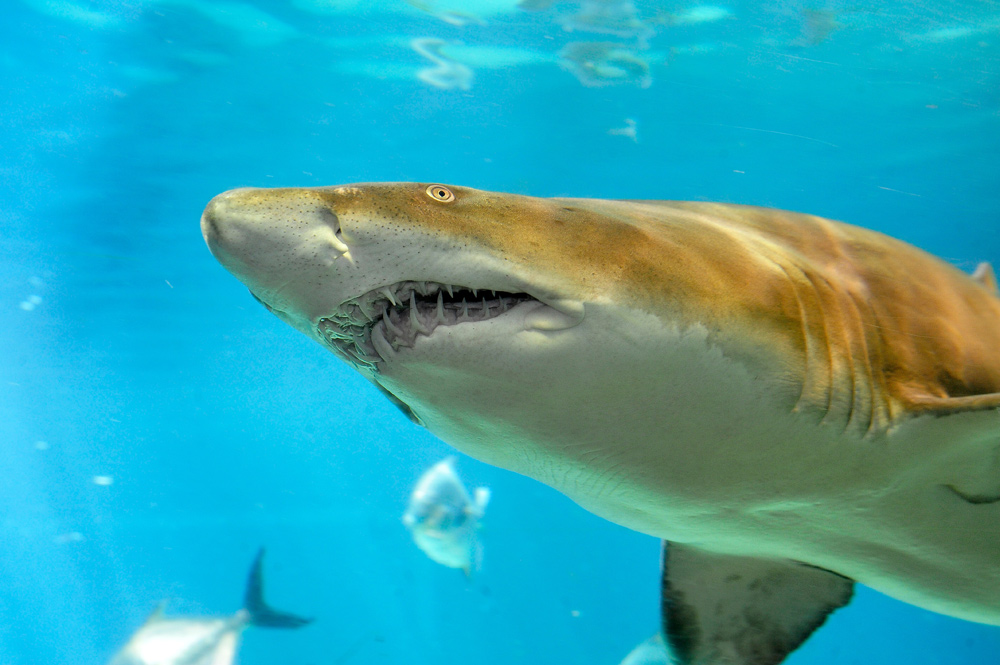Baby Sharks: Sand Tiger Nursery Spotted Off New York Coast

Shark tots just a few months old are making their way up the Atlantic coast to a nursery off New York, scientists have found.
The sand tiger shark nursery, located near the shore of Long Island's Great South Bay, supports the juvenile animals, which range from just months old to 4 or 5 years old and measure 9 inches to 4 feet (23 centimeters to 1.2 meters) long, according to the Wildlife Conservation Society's New York Aquarium.
"It's quite interesting, because this is sort of a resident population," said Jon Dohlin, vice president and director of the aquarium. "We think these animals migrate up the coast from where they're born at a very early age. They have these nursery habitats, which we're starting to delineate, which seem to be protective and great food sources. And they are resident there for three or four years until they get to a certain size" and start to migrate seasonally up and down the coast. [See Photos of the Sand Tiger Shark Nursery]
With their iconic toothy grins and flattened, narrow snouts, sand tiger sharks (Carcharias taurus)may look fearsome, but they are not considered aggressive animals. The sharks can grow to be up to 10 feet (3 m) long and weigh up to 350 lbs. (160 kilograms), according to the aquarium. And because they are denser than water and aren't equipped with a swim bladder (which holds gas to keep some fish buoyant), the animals instead gulp air and hold it in their bellies to keep themselves buoyant.
The team was first alerted to the possible nursery in 2011, when one of the scientists received a photo of a dead juvenile sand tiger shark from a local marina. It turned out —unsurprisingly, according to Dohlin — that the local anglers and boaters had plenty of anecdotal evidence about this shark nursery: They had been catching the small sand tiger sharks in the bay for years.
Dohlin and his team's data complemented that evidence. They tagged about 15 sand tiger sharks over the past three seasons, he said. [Photos: How to Tag a Hammerhead Shark]
Dohlin said the team is not providing detailed information on the location of this juvenile playpen of sorts, as the species is considered vulnerable by the International Union for Conservation of Nature and is a candidate for the U.S. Endangered Species List, according to the aquarium.
Sign up for the Live Science daily newsletter now
Get the world’s most fascinating discoveries delivered straight to your inbox.
"This is a protected spot," Dohlin told Live Science. "We're trying to be very careful about [the] specificity of what we say about where this area is."
The female sand tiger sharks' low reproductive rate — an individual gives birth to one or two pups every two years — means that rebuilding a population can take time, according to the aquarium. In that way, protecting this newfound nursery will aid in the recovery of the sand tiger sharks, he said.
"Right now, we're finding nothing that would concern us about the health of this population [of sand tiger sharks]," Dohlin said.
The nursery is also a natural laboratory where scientists can discover new information about the somewhat mysterious sharks.
"One of the reasons we are excited about this information is because there are a lot of unanswered questions," Dohlin said. For instance, how fast do the juveniles grow during this stage of their life cycle? What are the key factors that make this spot a good nursery? Do the juveniles return year after year? Is there some connection between where the females matured and where their pups mature?
These are just a few of the questions the shark nursery can help scientists answer, Dohlin said.
Follow us @livescience, Facebook & Google+. Original article on Live Science.
Jeanna Bryner is managing editor of Scientific American. Previously she was editor in chief of Live Science and, prior to that, an editor at Scholastic's Science World magazine. Bryner has an English degree from Salisbury University, a master's degree in biogeochemistry and environmental sciences from the University of Maryland and a graduate science journalism degree from New York University. She has worked as a biologist in Florida, where she monitored wetlands and did field surveys for endangered species, including the gorgeous Florida Scrub Jay. She also received an ocean sciences journalism fellowship from the Woods Hole Oceanographic Institution. She is a firm believer that science is for everyone and that just about everything can be viewed through the lens of science.









